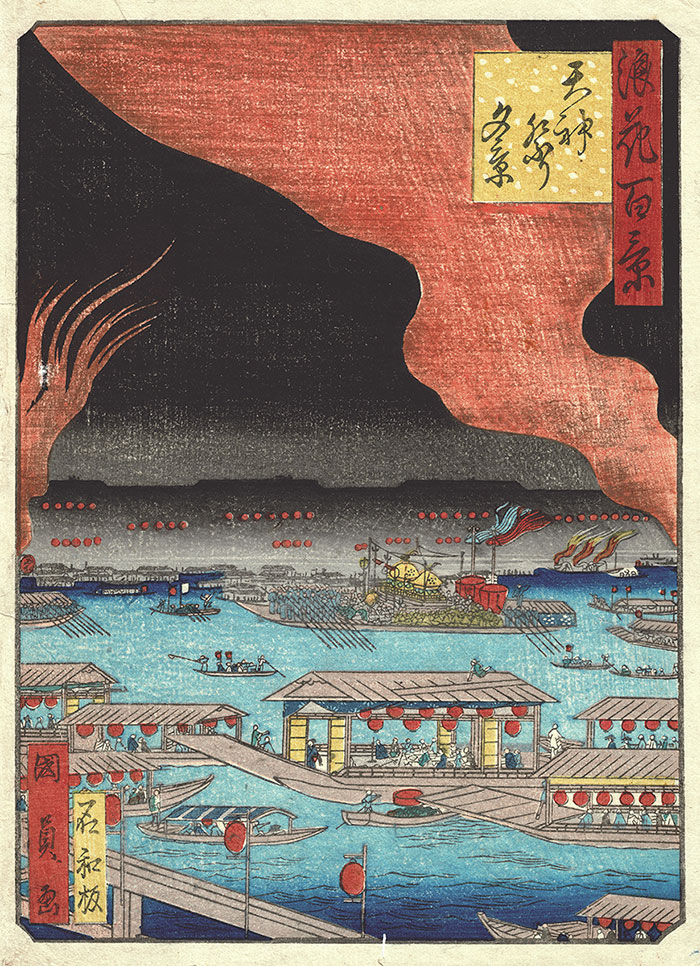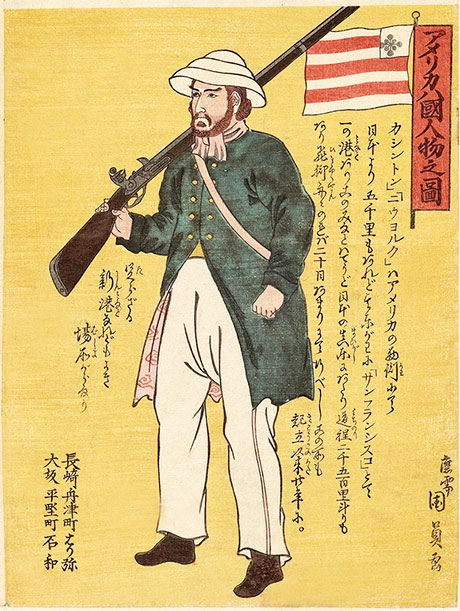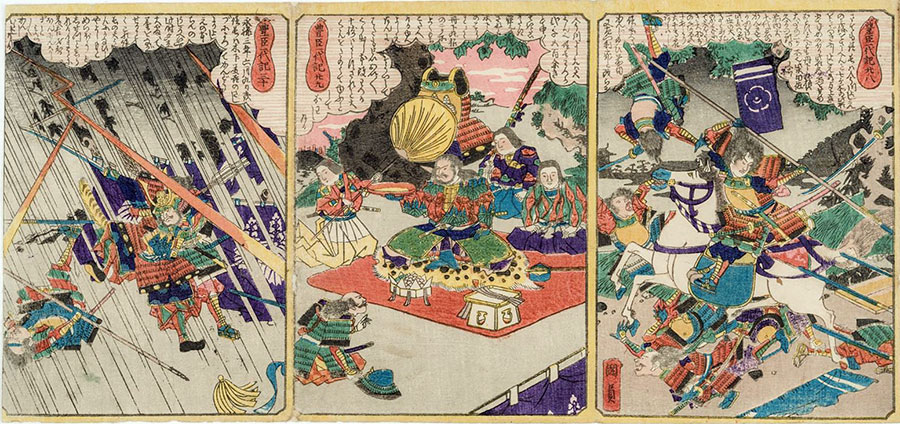

Isshûsai Kunikazu (一珠齋國員)Isshûsai Kunikazu (一珠齋國員 act. c. 1847-1881), an Osaka print designer, might have been a pupil of the Edo artist Utagawa Kunisada I (歌川國貞). At this time, hundreds of designs have been documented over a fairly long career, and it is possible that many more may yet surface as research continues. Kunikazu worked almost exclusively in small format (chûban, approx. 250 x 180 mm, and mameban, 130x100 mm or smaller,) covering subjects such as yakusha-e (actor prints: 役者絵), fûkeiga (landscapes: 風景画), bijinga (prints of beautiful women: 美人画), kachôga (bird-and-flower pictures: 花鳥画), musha-e (warrior prints: 武者絵), sensô-e (war prints: 戦争絵), Nagasaki-e (foreigners in Nagasaki: 長崎絵), and very rarely, surimono (privately commissioned prints: 摺物). However, at least one bijinga is known in the larger ôban format (approx. 370 x 260 mm untrimmed), as well as a few horizontal landscapes from a Tôto meisho series (see below).
The landscape tradition as an independent genre never really took hold in Kamigata printmaking as it had in Edo, although Osaka artists frequently included stage scenery drawn more like actual landscapes as minor motifs or settings in their actor-print designs. Nevertheless, some late-period Osaka artists such as Haegawa Sadanobu (1809-1879), and Ichiyôsai Yoshitaki designed landscape prints in a style derived from Utagawa Hiroshige I and Utagawa Hiroshige II. So did Kunikazu. A dynamic example of one of his fûkeiga is shown above, titled Tenjin matsuri yûkei ("Evening View of the Tenjin Festival: 天神祭り夕景) from the collaborative series Naniwa hyakkei (One Hundred Views of Osaka: 浪花百景) issued, it seems, in the late 1850s. Kunikazu contributed 40 images to the series, while Yoshitaki added 31 and Rokkaen Yoshiyuki (六花園芳雪 1835-79) produced 29. In the Tokugawa period, the Tenjin Matsuri (Heavenly Deity Festival: 天神祭り) was celebrated on the 25th day of the sixth lunar month in Osaka (today it takes place on July 25). Tenjin Matsuri is one of the three great Shinto festivals of Japan, along with Kyoto's Gion Matsuri (Gion Festival: 祇園祭) and Edo/Tokyo's Kanda Matsuri (Kanda Festival: 神田祭). The festivities take place at Osaka's Tenmangû Shrine, built during the Tenryaku Era (947-957) by imperial order of the Emperor Murakami (926-967). Kunikazu's Tenjin Matsuri yûkei depicts a procession of river boats from the Dôjima to the Okawa river. The large boat in the middle distance carries portable shrines. A vessel in the near middle distance features a stage where traditional Japanese court dances, folk entertainments, and geiko performances (dancing girls or young geisha) were held to the accompaniment of sacred Kagura and Dôgaku music. During the heyday of Tokugawa-period Osaka, more than 70 festival danjiri (floats: 地車) would be carried along the embankment as onlookers watched the pageant move upon a riverscape punctuated by red lanterns. The huge clouds of billowing smoke seen here are from festival bonfires. Kunikazu also collaborated on a related landscape series entitled Miyako hyakkei (One Hundred Views of Kyoto: 都百景) published by Ishiwa-ban (石和板) along with the artists Umekawa Tôkyo (梅川東居 act. c. mid 1850-early 1860s), Gyokuen (玉園 act. c. 1850s–75?), and Hokusui (北水 act. c. late 1850s–1860).
An artist signing as "Isshûsai Kunikazu" with identical Japanese characters (一珠齋國員) for his art name produced a few horizontal ôban landscapes for a print series titled Tôto meisho (Famous Views of the Eastern Capital: 東都名所), published by Wakamatsuya Yoshirô [Gensuke] (若松屋与四郎) circa 1847-1852. Assuming this "Edo" Kunikazu was the same artist as our Osaka print designer, an example of his work from the Tôto meisho series is shown above — Matsuchiyama no yuki (Snow at Matsuchiyama: 真乳山の雪). There is an obvious influence from Utagawa Hiroshige I and, perhaps, with a small measure of Keisei Eisen's landscape style also mixed into the rendering of the scene. Kunikazu, however, employs a more abrupt and angular transition from foreground to background than one usually finds in either Hiroshige or Eisen, and the human figures are not featured as they normally would be in Eisen's work. The transliteration of the inscription is: 親民(ハマシ) 末都ち山松のあらしのうつもれて 雪とけしつけきいほ崎の庵. The scholarly consensus seems to be that the Isshûsai Kunikazu who designed the Matsuchiyama print was the same artist who is known primarily as the Osaka actor-print designer said to be a former pupil of Utagawa Kunisada. If so, Kunikazu might have spent some time in Edo studying with Kunisada, perhaps even around the time that the Tôto meisho series was published. Alternatively, for this series, he might have simply emulated the prevailing Edo landscape style while working in Osaka. Note that the red artist's seal at the upper left resembles Utagawa Kuniyoshi's stylized kiri (Paulownia imperialis: 桐) emblem, hinting at some unconfirmed connection. However, all these links with Edo might have been artistic conceits by which Kunikazu (sponsored by his publisher) feigned legitimacy as an Edo artist to promote an Edo-style landscape series to be sold in Osaka. Complicating matters further, while the impression shown here lacks a publisher seal (or it was trimmed off in one of the vertical margins), the version in the Museum of Fine Arts, Boston (inv #51.26) has the seal of the Edo publisher Wakamatsuya Yoshirô (若松屋与四郎). Moreover, another design from the series has the seal of the Osaka publisher Honya Seishichi (本屋清七) and includes censor seals. Yet woodblock prints sold in Osaka did not require censor seals, and thus the seals might have been recarved "fakes" included to imitate true Edo-based censor approvals. More research is needed to determine the marketing history of this series. Note: There was a second Osaka artist of the period, active c. late 1854-58, who also signed as Kunikazu, but with the second character in his name written differently (國計).
A much admired actor-print series by Kunikazu is his Dai Nippon rokujû yo shû (Sixty-odd Provinces of Great Japan: 大日本六十余州) from circa 1862, which is known in both deluxe and standard editions. The connections between the kabuki scenes and the provinces (their particular histories or famous goods and services) are sometimes clever and entertaining. In the scene shown here, Nakamura Shikan IV (四代目 中村芝翫) performs the role of Unryû Kurô (雲竜九郎) and Ichikawa Ichizô III (三代目 市川市蔵) is Toraômaro Hayakaze (虎王麿早風) in a fanciful mitate (analogue: 見立) of Unryû Kurô chûtôden (The Thievery of Unryû Kurô: 雲竜九郎偸盗傳). The link is with Hôki province (伯耆). There seems to be no known kabuki play based on this ten-volume fiction book of the same title, begun by Rakutei Saiba (楽亭西馬 1799-1858), whose preface is dated in 1858, the year of his death. The work was then finished by Kanagaki Robun (假名垣魯文 1829-1894) and published in 1866-1867. It was illustrated initially by Utagawa Kunisada I (歌川國貞) in 1859-1861, and then by Kitao Shigemasa (北尾重政) and Utagawa Yoshitora (歌川芳虎). The impression shown above is from the early deluxe edition, with zinc-rich brass emulating gold in the title cartouche and costumes. In a scene of impressive intensity, the protagonists have conjured up a three-clawed (Japanese) dragon in clouds and a ferocious tiger as they call upon their occult powers. The magician Unryû ("Cloud Dragon") clutches a sacred sword wrapped in richly embroidered cloth, visible at the top right, while Toraômaro may be reciting incantations from an open scroll.
By far, the most frequently encountered works by Isshûsai Kunikazu are his yakusha-e in chûban and mameban formats. The triptych shown above, which is rarely found complete, portrays three leading actors of the period: (1R) Ichikawa Yonezô III (三代目 市川米蔵) as Hirai Gonpachi; (平井ごん八); (2R) Nakamura Komanosuke V (五代目 中むら駒之助) as Matsue Kurando (松江蔵人); and (3R) Nakamura Masajirô I (一代目 中村政治郎) as Shizuka Gozen (静御前). The actors are performing in roles from three different plays (still to be firmly identified). The mixing of roles and plays within a composition, or even on a single sheet, was an occasional compositional arrangement that appears to have been popular in 1850s-1860s Osaka. Setsugekka ("Snow, moon, flowers": 雪月花), a frequently encountered theme in classical and modern Japanese art and literature, was a perennially popular subject in ukiyo-e prints and paintings. Among other things, the subject served as an aesthetic embodiment of the Japanese view of nature and the belief in its everlasting beauty. Traditionally, designs representing the changing seasons are presented in scenes featuring snow (setsu or yuki 雪 evoking not only the winter season but also a prelude to rebirth), the moon (getsu or tsuki 月 symbolizing a year-round constant), and flowers (ka or hana 花 or 華 recalling the four seasons as well as the cycle of life). Here, however, we have a type of mitate ("likening pictures" or analogue images: 見立絵) in which modern-day kabuki characters and plays are linked with a classical theme.
Beyond actor prints and landscapes, Kunikazu dabbled in other genres. Within a few years after the official opening of Japan to the West in 1854-1855 through imposed trade agreements, he produced some Nagasaki-e (長崎絵), such as the view shown above left titled Amerikawa kuni jinbutsu no zu (Picture of a Person from America: アメリカワ國人物之圖). This chûban-format design was likely a pastiche of illustrations that Kunikazu had seen in various imported books, as he could not have actually traveled to America in the late Edo period. As such, these sorts of images often have incongruities or errors. Here, the American flag is, of course, incorrectly represented. The signature reads ôju Kunikazu sha (sketched by Kunikazu, on request: 應需國員写)。 Another genre that Kunikazu explored was sensô-e (war prints: 戦争絵), in particular his series on the Boshin sensô (War of the Year of the Dragon: 戊辰戦争), that is, the Boshin Civil War fought in 1868–69 between the Tokugawa shogunate and the pro-Imperial forces. The defeat of the shogunate led directly to the Meiji Restoration starting in 1868. Kunikazu's chûban-format series is titled Tôsei buyûden (Tales of Present-day Heroism: 當世武勇傳). Published in 1868 by Kawaden (川傳), the series of fifty-four (?) designs served as a kind of breaking-news reporting, only possible at that historical moment due to the fall of the Tokugawa shogunate, which had banned publications (both images and texts) about current political events. The image above right portrays Takahata Chitayû (髙畠知太夫), a warrior of the Maeda (前田) clan in Kaga province (加賀州), fighting on the imperial side during the Boshin sensô. The Maeda-Kaga clan took part in the imperial army's military action against Makino Tadakuni (牧野忠訓 1844-75), daimyô (military lord: 大名) of the Nagaoka Domain (長岡藩) who sided with the shogunate during the Echigo Campaign of 1868 (Hokuetsu sensô, Battle of Hokuetsu 北越戦争).Kunikazu's drawing of the flowing red cape set against the strong horizontals of flaming-orange gunfire and Takahata's rifle is creates a strong visual representation of a determined warrior bravely standing his ground in deadly conflict.
Kunikazu's series of musha-e (warrior prints: 武者絵) titled Toyotomi Ichidaiki (The Life of Toyotomi Hideyoshi: 豊臣一代記), probably from the late 1850s, presents thirty scenes of the shogun's life on ten hosoban sheets (each 160 × 358 cm), three views to a sheet. (Whether there are more sheets and scenes has yet to be verified.) Toyotomi Hideyoshi (豊臣秀吉 1537-98), born of an undistinguished lineage as the son of a peasant foot soldier named Yaemon, became a renowned warrior-general and politician. Toyotomi, a popular subject in ukiyo-e prints and paintings, is considered Japan's second great unifier in a series of three warlords: (1) Oda Nobunaga (織田信長 1534-82); (2) Toyotomi Hideyoshi; and (3) Tokugawa Ieyasu (the first shogun, 徳川家康 1543-1616). These historical giants gradually unified Japan after nearly 140 years of civil war (c. 1467 – c. 1603; called the "Age of civil war," Sengoku jidai: 戦國時代). Toyotomi was enormously popular in kabuki and literature; he was even the subject of woodblock-printed sugoroku ("double sixes": 双六 also 雙六), a game played with a single die and counters, somewhat like backgammon.
The last image shown here is an exceedingly rare surimono (privately commissioned print: 摺物) commemorating the shûmei (ascension to a name: 襲名) of a nagauta (long song: 長唄) specialist called Unomaru (卯の丸), who was given the name Hanafusa Hanshichi [II] (花房半七) by Hanafusa I, a master of nagauta in Keihanshin ("Kyoto-Osaka-Kobe": 京阪神) spanning some of the years from the Kôka (弘化 1844-1848) to the Meiji (明治 1868-1912) periods. Nagauta is a style of jôruri music accompaniment in Bunraku (puppet theater) and Kabuki plays originating in Osaka in the late seventeenth century and becoming popular in Edo by the 1720s, reaching its apex there around 1750. The congratulatory poems were written by, it seems, fellow nagauta practitioners — Tamamura Shiraku (玉村芝樂), Nakamura Shinsaburô (中村新三郎), Bandô Sadajirô (板東定次郎), Tamamura Mimazô (玉村巳馬造), Bandô Isaburô (板東伊三郎), and others. Isshûsai Kunikazu's Names Surname: Art Name (geimei): Art Pseudonyms (gô): Pupils of Isshûsai Kunikazu So far, no pupils have been identified. © 2021 by John Fiorillo BIBLIOGRAPHY
|
Viewing Japanese Prints |





_420w.jpg)

